
Ground spiders comprise Gnaphosidae, the seventh largest spider family with nearly 2,000 described species in over 100 genera distributed worldwide. There are 105 species known to central Europe, and common genera include Gnaphosa, Drassodes, Micaria, Cesonia, Zelotes and many others. They are closely related to Clubionidae. At present, no ground spiders are known to be seriously venomous to humans.

Araniella cucurbitina, sometimes called the "cucumber green spider", is a spider of the family Araneidae.

Baetidae is a family of mayflies with about 1000 described species in 110 genera distributed worldwide. These are among the smallest of mayflies, adults rarely exceeding 10 mm in length excluding the two long slender tails and sometimes much smaller, and members of the family are often referred to as small mayflies or small minnow mayflies. Most species have long oval forewings with very few cross veins but the hindwings are usually very small or even absent. The males often have very large eyes, shaped like turrets above the head.
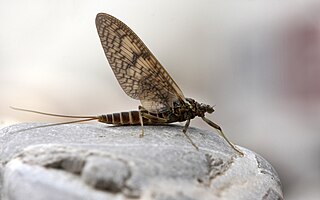
The Heptageniidae are a family of mayflies with over 500 described species mainly distributed in the Holarctic, Oriental, and Afrotropical regions, and also present in the Central American Tropics and extreme northern South America. These are generally rather small mayflies with three long tails. The wings are usually clear with prominent venation although species with variegated wings are known. As in most mayflies, the males have large compound eyes, but not divided into upper and lower parts.
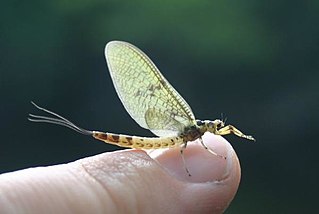
Ephemeridae is a family of mayflies with about 150 described species found throughout the world except Australia and Oceania. These are generally quite large mayflies with either two or three very long tails. Many species have distinctively patterned wings.
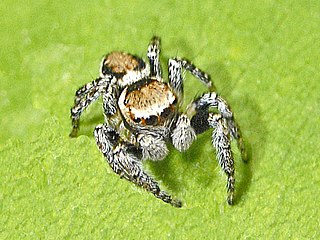
Evarcha falcata is a species of 'jumping spiders' belonging to the family Salticidae.
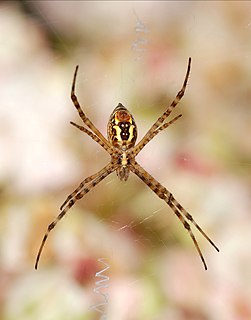
Argiope trifasciata is a species of spider native to North and South America, but now found around the world. It can be found in certain areas of Europe, namely the Iberian Peninsula, the Canary Islands, and Madeira, The similar looking Argiope bruennichi is common in the Azores. They typically begin to appear during autumn from early September to late October as temperatures start dropping.
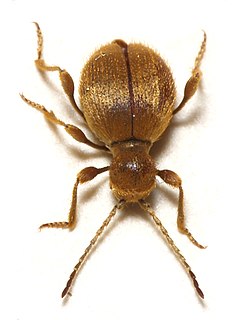
Spider beetles make up the subfamily Ptininae, in the family Ptinidae. There are approximately 70 genera and 600 species in the subfamily, with about 12 genera and 70 species in North America north of Mexico.
Fauna Europaea is a database of the scientific names and distribution of all living multicellular European land and fresh-water animals. It serves as a standard taxonomic source for animal taxonomy within the Pan-European Species directories Infrastructure (PESI). As of June 2020, Fauna Europaea reported that their database contained 235,708 taxon names and 173,654 species names.
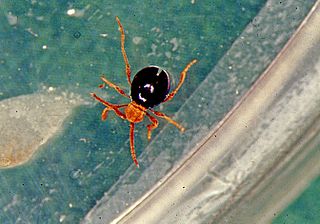
Mezium is a genus of beetles in the subfamily Ptininae, the spider beetles. It is distributed throughout most of the world. There are two centers of distribution: an area extending from the Iberian Peninsula to Morocco, including the Canary Islands; and an area extending through central and southern Africa. Several species are recently described African endemics. They are most common in coastal areas, and in regions with a Mediterranean climate.

Ptinus is a genus of beetles distributed throughout much of the world, including Africa, the Australian region, the Palearctic, the Near East, the Nearctic, and the Neotropical realm. It is a member of the subfamily Ptininae, the spider beetles.
C. europaea may refer to:

Spiders are air-breathing arthropods that have eight legs, chelicerae with fangs generally able to inject venom, and spinnerets that extrude silk. They are the largest order of arachnids and rank seventh in total species diversity among all orders of organisms. Spiders are found worldwide on every continent except for Antarctica, and have become established in nearly every habitat with the exceptions of air and sea colonization. As of July 2019, at least 48,200 spider species, and 120 families have been recorded by taxonomists. However, there has been dissension within the scientific community as to how all these families should be classified, as evidenced by the over 20 different classifications that have been proposed since 1900.
Camillina elegans is a spider species in the genus Camillina. It is found in the Caribbean, in Angola and in the Pacific Islands.

Anoplius is a genus of spider wasps in the family Pompilidae, called the blue-black spider wasps.

Oxyopes lineatus is a species of spider in the family Oxyopidae, the so-called lynx spiders.

Trebacosa is a genus of wolf spiders first described by Dondale & Rednerin 1981.
Trebacosa europaea is a wolf spider species in the genus Trebacosa found in France, Hungary, Belarus and Greece.
Echemographis is a genus of South American spiders in the family Gnaphosidae, and was first described in 1955 by Caporiacco. As of 2017, it contains only one species, Echemographis distincta, found in Venezuela. It is possibly a synonym of Camillina.
Camillina pulchra is a species of ground spider in the family Gnaphosidae. It is found in Brazil, Argentina, and has been introduced into the United States.













